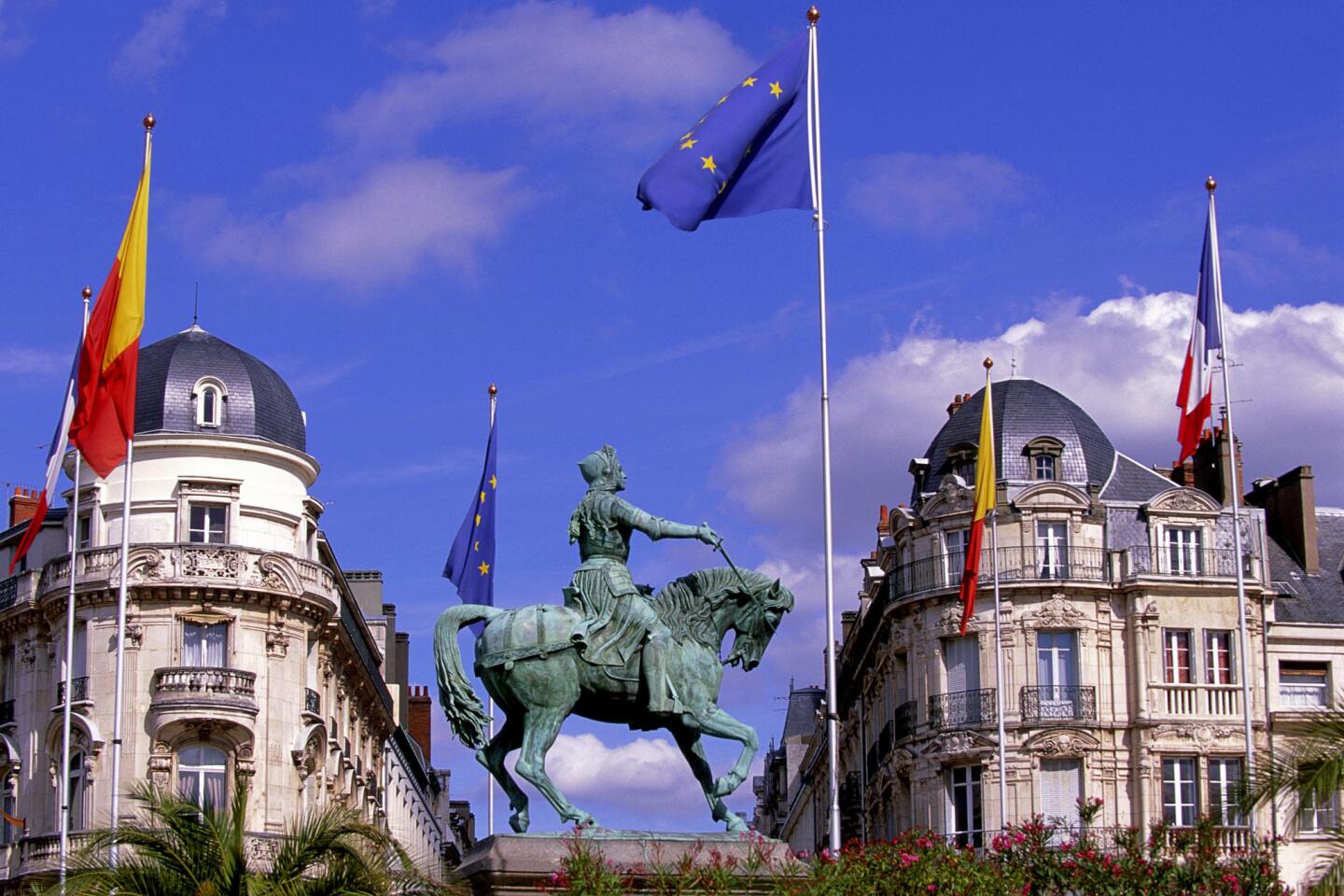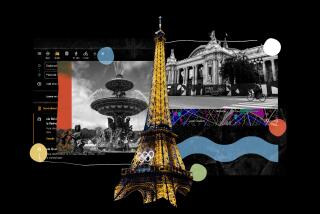Lens, Lille, Metz and Orléans join Paris on France’s cultural map
- Share via
LENS, France — Paris, Paris, Paris. The city has stolen France’s cultural spotlight for far too long.
The French government, along with local officials and prestigious institutions, is aware of Paris’ gluttony and is trying to spread the wealth to nearby cities through satellite facilities and museum additions.
As in Bilbao, Spain, with its Guggenheim Museum, the work has paid off, helping these towns’ economies and bolstering their civic profiles. Visitors also benefit by getting to experience new landmarks created by some of the world’s best architects; the smaller crowds are another bonus.
The shimmering buildings are especially fun to explore during this chilly time of year, when being inside all day isn’t such a bad idea.
These cities — all within two or three hours’ driving time from Paris — are great destinations in their own right, showcasing a grittier, more lively France than most visitors are accustomed to. They’re still somewhat off the radar, but that’s changing fast.
Lens
Lens, about two hours north of Paris, is a sleepy coal-mining town that few people knew much about until the Louvre opened its satellite museum, housing many of the institution’s long-cloistered treasures, in 2012.
The $187-million Louvre-Lens, built atop a former mining field, was designed by Pritzker Prize-winning Japanese firm SANAA and shows off its ability to create serene sculpture.
Unlike the sprawling Paris Louvre, the satellite’s aluminum and glazed wings and public spaces are all on one level, spread out from a glass entrance hall around an undulating landscape. Inside, the galleries are straightforward, not radical. This is the Louvre, after all. But the repetition of structure and the luminous reflections are nonetheless mesmerizing.
The treasures inside — from Egyptian idols to Greek statues to European paintings — are evidence of the astonishing depth of the Louvre’s collection, as is a basement-level viewing area of the museum’s massive storage and restoration spaces.
Lens isn’t Paris, but if you’re tired of the streams of tourists in the French capital, this place is for you.
In some parts of town, you feel as if you’ve wandered onto the set of the British film “Billy Elliot,” with long rows of red brick houses dotted by the occasional pub. Look closer and you can appreciate the rough beauty of the city’s Beaux-Arts, Art Nouveau and traditional Flemish buildings, all hiding in plain sight.
Lens’ main street, Place Jean Jaurès, is an ideal spot to enjoy a coffee and quiche (I tried the Jean-Claude Jeanson Pâtisserie) and stare at the stately clock tower of the quirky orange brick Église Saint-Léger.
On your way out of town, gaze at the huge heaps of mine refuse known as terrils. Once considered eyesores, these cone-shaped hills are now an integral part of the re-emerging city’s identity.
Info: www.louvrelens.fr/en/home
Lille
Lille, about half an hour north of Lens, doesn’t need to prove itself. Once deemed a grungy afterthought, it’s now considered one of France’s must-see cities, with a frenetic night life and world-class art scene.
Its reputation was cemented in 2010, when rising French architect Manuelle Gautrand restructured its Museum of Modern Art, a 1980s institution in the eastern suburb of Villeneuve-d’Ascq, now renamed the Lille Métropole Museum of Modern, Contemporary and Outsider Art.
The original red brick museum contains masterpieces by Joan Miró, Paul Klee and Amedeo Modigliani along with a sculpture garden featuring the works of Alexander Calder, Pablo Picasso and more.
Its new wing, an askew collision of concrete boxes embellished with oddly shaped openings, houses the largest collection of outsider art in France. With its eerie and often hilarious drawings, ornate concoctions of found materials and strange oversize sculptures, the addition is easily the complex’s highlight. I love its lofty progression of spaces, but the lighting needs work. Make sure to visit the serene duck-filled park just adjacent.
If you have time, Lille is one of the best surprises in France. Stroll through its varied historic quarters, taking in the fascinating mash-up of Flemish, French, Dutch and other building styles. Its cathedral, Notre-Dame de la Treille, with a translucent white marble facade, is strange and captivating.
More highlights for the art lover include the Palais de Beaux-Arts, one of France’s most extensive museums, and the nearby La Piscine, Musée d’Art et d’Industrie, an eclectic gallery housed in a former Art Deco swimming pool north of the city. You can also investigate the city’s many galleries and artisan shops, walk through its glorious Renaissance-style Citadelle and feast on beef stew, fries and Belgian waffles at local dining institutions Chez la Vieille and Meert.
Info: www.musee-lam.fr
Metz
In 2010, the Centre Pompidou opened its first satellite museum on the edge of Metz, a delightfully untouristy city about three hours northeast of Paris.
Designed by Japanese architect Shigeru Ban, another Pritzker Prize winner, the $86-million structure is essentially a series of extruded glass boxes topped with a curving canopy of crisscrossing laminated wood beams and translucent plastic fabric. (The shape was reportedly inspired by a hat that Ban found in Paris.)
Its white outer shell encloses a huge lobby, where you’ll spend a few minutes craning your neck toward the groovy, basket-like grid of supports. Thanks to huge roll-up glass doors, the lobby feels open to the city; you’re energized here in the middle of it all.
Galleries include cavernous spaces for oversize art by Georges Braque, Max Ernst, Robert Delaunay, Henri Matisse, Anish Kapoor and others, and more intimate upstairs spaces for temporary shows.
On the top floor, you can gaze up close at the canopy from projecting balconies, or take in views of the city through large projecting picture windows.
Metz, the capital of Lorraine, contains a head-turning Imperial quarter and a fascinating medieval core, with winding cobblestone streets, a bustling covered market and Saint-Stephen, one of the most stunning cathedrals in France. A small island in the Moselle River, highlighted by the picturesque Temple Neuf church, looks like a miniature version of Paris’ Île de la Cité. You’ll find lots of parks to explore in this bike-friendly city.
It’s also about 40 minutes from Nancy, the Art Nouveau capital of France, a great place for a day trip. Be sure to visit the Musée de l’École de Nancy, offering the greatest hits of one of my favorite styles (including sinuous Art Nouveau pianos, furniture, ceramics, etc.), and the Villa Majorelle, one of the most magically ornate homes you’ll have the pleasure of seeing.
Info: www.centrepompidou-metz.fr/en/welcome
Orléans
Known as the most famous battleground of Joan of Arc, Orléans, about an hour south of Paris, was badly damaged during World War II. It’s often regarded as just a stopping point on the way to the châteaux of the Loire.
But the diverse city has a burgeoning design scene that was crystallized in 2013 by the opening of a new complex for the FRAC Centre — a home for art and architecture exhibitions since 1983 — inside and around a renovated military barracks and hospital.
The glimmering, metal panel-clad new part of the museum, twisting and sloping around its shifting plaza, appears to be climbing out of the earth. To me, it resembles an insect, a heart valve, a spaceship or some combination of all three.
Its small perforations glow with colorful electronic displays, and you can even climb on top of it. The new construction was designed by French stars Jakob + MacFarlane, who have created several pulse-accelerating buildings in the country such as the lime green Docks de Paris and the aptly named Orange Cube in Lyon.
The FRAC is one of the world’s best showcases for utopian architecture; its permanent collection contains hundreds of models, drawings and head-scratching city plans from the likes of Le Corbusier, Ant Farm and Superstudio.
Temporary shows supplement this mix, filling an architecture fan with spectacular dreams that, while inspiring, will probably never be realized.
I didn’t have much time to explore Orléans, but I was able to visit the magnificent cathedral, with its three massive doors and rose windows, and, of course, the statue of Joan of Arc sitting amid one of the city’s many pleasant squares.
On my way out, I passed more stunning buildings, diverse neighborhoods, unexpected restaurants and more of the things that make these lesser-known cities so special.
Info: www.frac-centre.fr/index.php?lang=2
::
If you go
THE BEST WAY TO PARIS
From LAX, Air France and Air Tahiti Nui offer nonstop service to Paris, and American, British, Delta, KLM, Lufthansa, Swiss and United offer connecting service (change of planes). Restricted round-trip fares begin at $849, including all taxes and fe
More to Read
Sign up for The Wild
We’ll help you find the best places to hike, bike and run, as well as the perfect silent spots for meditation and yoga.
You may occasionally receive promotional content from the Los Angeles Times.






